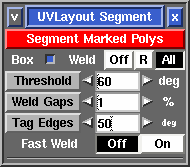User Guide: Segment
From UVLayout Docs
(Difference between revisions)
| Revision as of 01:38, 15 December 2015 (edit) Headus (Talk | contribs) ← Previous diff |
Revision as of 04:49, 24 March 2016 (edit) (undo) Headus (Talk | contribs) Next diff → |
||
| Line 7: | Line 7: | ||
| ; Threshold : This angle determines at which point adjoining polys are split apart. Increasing this angle will result in less fragmentation (i.e. fewer shells), but there will be more distortion in the resulting UVs and extra cuts or darts may need to be added. Reducing this angle will increase the fragmentation, and so more time will need to be spent welding shells back together. | ; Threshold : This angle determines at which point adjoining polys are split apart. Increasing this angle will result in less fragmentation (i.e. fewer shells), but there will be more distortion in the resulting UVs and extra cuts or darts may need to be added. Reducing this angle will increase the fragmentation, and so more time will need to be spent welding shells back together. | ||
| + | |||
| + | : The grey '''Threshold''' button gives you the option to manually segment some or all of your model. Mark one or more faces with the '''G''' hotkey, then click the button and adjacent polys facing the same way, within the threshold, will be filled in. | ||
| ; Weld Gaps : [[Image:UserGuide-Weld-Gaps.png|right|350px]] During the final welding phase, UVLayout checks for any narrow V shaped seams in the UVs, and these are also stitched up. Normally "narrow" means than the gap between the end points is less than '''1%''' of the length of that edge, but you can increase that with this setting. A larger percentage will mean that wider gaps will also be stitched up. | ; Weld Gaps : [[Image:UserGuide-Weld-Gaps.png|right|350px]] During the final welding phase, UVLayout checks for any narrow V shaped seams in the UVs, and these are also stitched up. Normally "narrow" means than the gap between the end points is less than '''1%''' of the length of that edge, but you can increase that with this setting. A larger percentage will mean that wider gaps will also be stitched up. | ||
Revision as of 04:49, 24 March 2016
|
[Professional Version Only] The Segment tool is used to speed up the flattening of "hard" surface geometry, that is, non-organic shapes like buildings, furniture and other props.
|

